
Our return to Georgia started out uneventfully, with a wonderful visit to Columbus, the third-largest city in the state and located near the west-central border of the state — along the Chattahoochee River (a tributary of the Apalachicola River) — about 100 miles southwest of Atlanta.
Fun and crazy fact: Columbus is the birthplace of Coca-Cola… first invented as an alcoholic drink named Pemberton’s French Wine Coca Never Tonic in 1885; in 1886, in response to a county (alcohol) prohibition ban, Coca-Cola was born — a nonalcoholic version of the tonic. John Pemberton, who was wounded in the Civil War and became addicted to morphine, developed the original tonic as a substitute for the powerful drug.
Thus, it only made sense that the first place we visited in Columbus was the Coca-Cola Space Science Center (CCSSC). Established in 1996, the CCSSC is Georgia’s only science center and museum facility dedicated to providing experiences for students and public visitors in astronomy and space science. The CCSSC is a division of Columbus State University (CSU) and serves as an academic enrichment center for the university and a regional informal education institution for the public and is located on the university’s Riverpark Campus on Front Avenue in the south end of Uptown Columbus.
We absolutely loved our visit — taking in all the exhibits, having fun in the Space Shuttle Odyssey interactive experience, being goofy with the green screen, and enjoying TWO shows in the center’s planetarium. (The center has a state-of-the-art planetarium and the largest collection of NASA Shuttle artifacts in Georgia.)
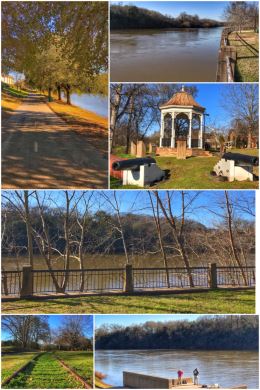
Because the CCSSC is located right along the river, we decided to take advantage of the city’s amazingly wonderful Chattahoochee RiverWalk, a 15-mile paved trail park that hugs the banks of the Chattahoochee River (which is the border between Alabama and Georgia)…. the trail extends from the cotton mill village of Bibb City, through downtown Columbus, and ends near Fort Benning.
Back in the 1800s, the river served as a major transportation tool for cotton and other elements. The Oxbow Meadows Environmental Learning Center, located near the southern end of the trail, is another great place to visit. The RiverWalk is part of the Dragonfly Trails network, the city’s effort to connect more than 60 miles of trail throughout Columbus — for “recreation, transportation, and interaction.” Dragonfly was chosen as the name because dragonflies are an indicator species for clean water in a community…. and the Chattahoochee River has made major strides in becoming much cleaner (and safer) after decades of spills and pollution.
Another part of the city’s network of trails is the Columbus Fall Line Trace, an 11-mile trail that follows the former right-of-way of the Norfolk Southern Railroad… and which connects to the Chattahoochee Riverwalk.
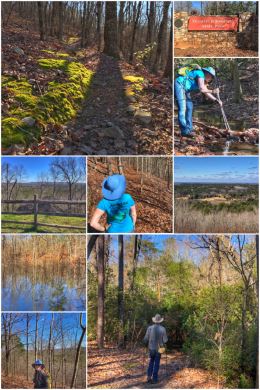
The next day we decided to tackle a real hike on the Pine Mountain Trail (PMT), located about 30 miles north of Columbus. The 22+ mile PMT offers lots of opportunities to hike — and to make it even easier, offers multiple loop opportunities.
The Pine Mountain Trail travels through F. D. Roosevelt State Park, Georgia’s largest state park at 9,049 acres, and named for the president who came to the area seeking healing for his paralytic illness from the natural springs. (The Little White House in nearby Warm Springs was used by Roosevelt as a presidential retreat; it is now a museum). Several park amenities were built by the Civilian Conservation Corps during the Great Depression, including fish hatcheries (which we hiked to), cottages, and the spring-fed Liberty Bell swimming pool. Besides more than 40 miles of trails, the park also offers cottages, camping opportunities (RV and primitive tenting), shelters, picnicking, swimming, fishing, and boat rentals.
Our main focus was on the with the PMT was the Overlook Loop, a 3.4-mile loop formed by hiking 1.3 miles of the main PMT and then continuing another 2.1 miles on the Chestnut Oak Trail. We started this hike from the parking area across from Callaway Country Store. (You can also start the hike from the Gardens Overlook Parking Area on Hwy 190.) Also nearby is Callaway Gardens, a 13,000-acre garden (and butterfly center) that includes golfing, fishing, biking, hiking, and ziplining opportunities — as well as lodging and dining.
Our main reason for returning to Georgia, though, was catching up with more of Ran’s family — including two brothers and a daughter and grandson — all of whom live in and around Atlanta… Georgia’s capital and most populous city. Atlanta traffic is insane — busy at almost all hours — and the drivers mostly insane as they cut in and around you to save all of five seconds.
Atlanta and Stone Mountain
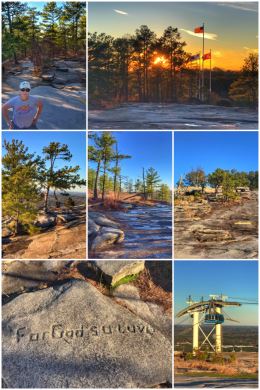
Happily, we stayed away from the craziness of the city by camping at the Stone Mountain Family Campground in Stone Mountain Park, which was okay in terms of facilities — but wonderful for the hiking and interesting geology.
Stone Mountain is a quartz monzonite dome (igneous rock) monadnock (isolated hill or small mountain) that reaches a height of almost 1,700 located about 15 miles east of Atlanta. (The base of the mountain continues 9 miles underground.) Some people have mistakenly referred to Stone Mountain as the “largest exposed piece of granite in the world.” To make matters more confusing, granite was quarried in the area in the late 1800s; Stone Mountain granite was used in many buildings and structures, including the locks of the Panama Canal and the steps to the East Wing of the U.S. Capitol.
We immediately made a plan for hiking the summit of Stone Mountain on the Walk-Up Trail — a 2-mile (RT) moderate hike (with about a 700-foot elevation gain) up to the summit and back. The trailhead is located next to Confederate Hall (which houses the museum and an interesting film on the park’s development).
The 3,200-acre Stone Mountain Park is Georgia’s most visited attraction — and offers all sorts of amusements and adventures, including hiking trails, lakes for boating and fishing, campgrounds, scenic railroad and summit aerial tram rides, and laser-light shows, as well as a museum, lodging, and golfing. The park also includes a 732-bell Carillion, originally exhibited by the Coca-Cola Company as “Carillion Americana” at the 1964 World’s Fair in New York. (It was donated to Stone Mountain Park by the company in 1965.)
The land was purchased by the State of Georgia in 1958 “as a memorial to the Confederacy’ and oddly opened 100 years to the day that President Abraham Lincoln was assassinated. On the mountain’s north face sits the largest bas-relief sculpture in the world, depicting three Confederate figures: Jefferson Davis, Robert E. Lee, and Stonewall Jackson. The idea for the sculpture started in the early 1900s but was not completed until 1972.
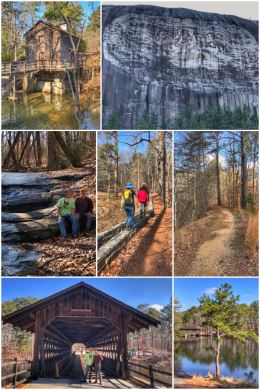
The next day we met up with Ran’s brother Brad and decided to hike around the base of Stone Mountain, hiking mostly on the Cherokee Trail (a National Recreation Trail), but also parts of the Connector Trail on the east side of the mountain… for a total of 6.89 miles through mostly oak-hickory (and pine) forest, crossing streams and navigating shores of the two main lakes.
The hike was a wonderful way to see the different sides of the mountain, as well as some of the other features of the park, including: Stone Mountain Lake (the largest water body in the park at 323 acres) and Venable Lake (named for the brothers who owned the mountain at one time); several season quarry ponds; Washington W. King Bridge (a covered bridge built in 1891 and relocated to the park from its home in Athens, GA); and Grist Mill (an abandoned mill that was built in 1869 and relocated from its original site near Ellijay, GA).

Later in the week, we had one of the highlights of the trip when we got together with Ran’s two brothers and his daughter and grandson for an afternoon and evening of good food and great conversations and connections… a much-needed family reunion.
It’s a bit funny because they all live in the Atlanta area, but rarely get together as a group… so we made it happen with another batch of Ran’s Turkey Red Thai Curry and some wonderful wine offered up by Wes and Brian. And with Jen’s help prepping the ingredients and chatting up all the family members, we just had a truly pleasant evening of kinship. It was great seeing both brothers, but even more amazing to see what a wonderful boy Ran’s grandson Jackson is becoming — smart, funny, and polite.
Before leaving Atlanta, we also got to spend some quality time with Wes, visiting some home hardware and plumbing stores discussing options and ideas for the upcoming construction of our home at H3 (Hansen Hilltop Haven) in Eastern Washington.
We also shopped at two Cosco Wholesale locations, one in Brookhaven (store #1084), and the other in Duluth (store #187), where we also bought gas.
Tire Blowout Dramatically Changes Plans

We left Atlanta feeling wonderful. We had spent quality time with both brothers, had the family reunion, and done some fun hikes in Stone Mountain Park, but as we made our way up to our next planned stop in Greenville, South Carolina, we had a tire blowout on the trailer along I-85 near Commerce, Georgia, about 65 miles northeast of Atlanta.
Happily, no one was hurt. We heard the tire blow and we able to safely pull the truck and trailer to the shoulder of the highway. We have roadside assistance and contacted them to help put the spare tire on so that we could continue on the journey. Unfortunately (or fortunately), the tow truck driver was afraid the axle had bent from the blowout. So, we had the trailer towed to his yard because it was Sunday and no RV repair shops were open.
We also decided to call our insurance company, Progressive, because after towing the trailer, the driver was also considered that the frame was bent. Progressive has been amazingly wonderful throughout the whole experience. Our coverage even includes a $750 hotel allowance — which turned out to not nearly be enough to cover our expenses, but at least it paid a chunk of it. Progressive also covered the new axle, alignment, and labor costs.
Once the trailer was at the RV repair facility, we learned that the axle would indeed need to be replaced and that the rear axle might also need alignment — and that we should get four new tires. But the worst news — and potentially devastating news — was that the shop found a crack in the trailer’s frame… one that could cause the trailer to split apart on the road if not repaired (though they had no idea how to repair it.). We discovered our frame has a three-year warranty and so we sought out a repair under the warranty — or at the very least the guidelines for repairing the frame, if possible. After much back-and-forth and at first denying the claim, both the frame manufacturer (Norco) and the trailer manufacturer (Keystone) came through in paying for both the parts and labor for fixing the frame.
In all, we had to put a halt to our adventures for three+ weeks, canceling a few of the places we had planned to visit, and moving our stuff from one hotel to another — until we found an amazing temporary home in a TownSuites by Marriott in Lawrenceville. We love the staff and so appreciate that they worked with us to get a good nightly rate.
The obvious upside from this experience is that the trailer is now safer than it ever has been… and after having some serious doubts that we were going to be able to finish the 48-state adventure, we now know we can and will. The other upside is the time spent “stuck” in the crazy traffic of the Atlanta area allowed us to spend more time exploring the area — and more time with Ran’s brothers. In the end, we spent about $2,500 at the RV dealership for repairs and almost the same for our stay at the Townplace Suites… so a $5,000+ investment in the local community.

A few days after the accident, we met up with Wes at Chateau Elan for a little wine-tasting and counseling. The winery, located in Braselton (about 40 miles north of Atlanta), is part of a massive complex — including a resort and spa, golf and tennis, as well as a high-end residential community. The winery is located in the chateau and while the three of us thoroughly enjoyed the tasting, it was also the most expensive tasting outside of Napa — about $40 per person for the premium selection, which includes six+ pours from their entire wine list (including limited release Fingerprint Collection, sparkling wines, and ports). As you might expect, many of the wines are produced from grapes from outside of Georgia, though they do have a vineyard planted with Muscadine grapes. All three of us focused on a variety of their reds (including a number of tasty blends)… In the end, we decided that the wines were fine, but not worth the prices. Still do not know how the winery gets away with such a high tasting fee.
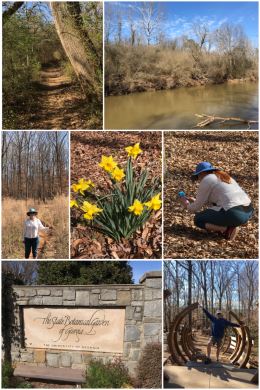
The next day, we decided to explore more of the area — and more natural settings — with a trip to Athens and the State Botanical Garden of Georgia, a 313-acre park south of Athens founded in 1968 and which borders the Middle Oconee River.
Given its location in Athens, it is no surprise that the gardens are a public educational facility operated under the auspices of the University of Georgia. It is a “living laboratory” for university students and faculty who utilize the collections and natural plant communities for studies in a variety of disciplines. The Garden is also a public garden for enjoyment by the general public who find beauty, knowledge, and solitude in a garden setting. In total, there are seven color-designated trails at the State Botanical Garden: Red, Blue, Green, Brown, Yellow, Orange, and White.
We attempted to hike the White Trail, which travels along the river toward the end of the trail. After a bit of a shaky start, we found the trailhead near one of the parking lots near the visitor center (where there is new construction taking place) and completed a 4.2-mile loop. AllTrails lists the trail as easy, but for its length and multiple travels up and down hills and between steep stream valleys, we would rate it as a moderate hike. It was along this trail that we started seeing daffodils blooming.

Amazingly, the next day the temperatures dropped and it snowed!
You have to remember in Atlanta, even just a few inches brings both excitement and fear… some folks run out to make tiny little snowmen while others totally freak out while driving in it.
We sat in our suite in the Townplace Suites in Lawrenceville and watched the massive flakes fall — as can be seen in the pictures. And speaking of our hotel, we have to again express our gratitude for the hotel working with us on the price — and for the excellent customer service we received from the entire staff. We also have to admit that we loved the exercise space in the hotel — which includes free weights, exercise balls, several treadmills, an elliptical machine and a stationary bike.
Looking for things to do inside in the area led us to the North Atlanta Home Show at the nearby Infinite Energy Center in nearby Duluth.

The home show was a win for many reasons. First, we were looking for ideas for our future home. Second, we were looking forward to people-watching and experiencing a trade show together for the first time. Third, it got us walking and moving in a climate-controlled environment rather than in the snow!
We had a blast walking around all the booths and talking with a number of experts on topics such as flooring, cabinets, windows, drawer inserts, garage floor coatings, hummingbird feeders, and massage chairs. There were also quite a few gutter and roofing and window replacement folks we quietly ignored. The show had just about every type of home-related product and service — showcased with inspiring displays. There were also several informative presentations from renowned home professionals.
Finding Live Music
Later that day, seeking a little nightlife, we found a concert right down the street from our hotel in Lawrenceville. We did a search on Google for “concerts near me” and up popped a concert for two musicians: Brytly and Logan Pilcher.
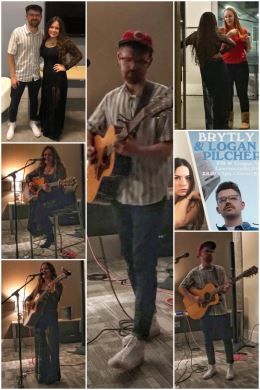
The setting in Cornerstone Coworking was intimate — and perfect for this beautiful and powerful concert.
Logan started the concert, performing a mix of songs. Logan grew up in a musical family, but really took to writing his own songs and music after high school. He’s from Nashville, but now lives in Florida — but travels the southeast on weekends performing shows. From his website: “His organic, layered tones and finger-style acoustic picking both tranquilize and wake the spirit. His lyrics tell a story of unapologetic love.”
Brytly finished the concert with a set of mostly original songs and one cover. We loved her silky voice and beautiful personality. Brytly (real name Codi Lester) is a South Carolina native who moved to the Atlanta area a few years back (after college) to work on her music career. She has been described as having “a unique mixture of modern pop and traditional southern sounds” and her songs are deeply personal.
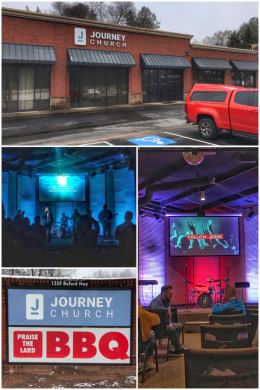
Codi is also a Christian and just walked up to us and invited us to come and attend her church the next day. We have been wanting to attend different church services while on the road, but our schedules never really allowed it — and we keep ourselves spiritually fulfilled watching video sermons from our previous church, North Coast Church, as well as listening to the podcasts of our friend Pastor Shane.
Taking it as a sign from God, we decided to try out Journey Church in nearby Buford. The people are wonderful and the church service relaxed — with beautiful and inspiring music and an energetic and thought-provoking sermon from Pastor Allen Taylor. Here’s their message of belief: “We are about loving God, loving people, seeking truth, and being authentic. Worshiping God should be a part of our everyday, ordinary, walking-around life…woven into who we are and what we do.” Their vision is Find it – Live it – Share it: “Our purpose is to create an atmosphere where people Find Jesus, learn how to Live a life that imitates Jesus, and encourage each other to Share Jesus and see lives changed.”
We loved our first visit so much, we went back the next Sunday. While the videos and podcasts are wonderful, we really loved being back in a small and cozy (and friendly) church. This type of church is what we hope to find in the Spokane area this summer when we start our next adventures at H3.
More Jazzercise!

Journey Church get our spirituality in high gear, but we also needed something to kick our brains in high gear — and kick our butts given all the wet weather… and the answer was multiple workouts at the Sugarloaf Jazzercise in Duluth — including Dance Mixx and Fusion classes. The studio is located in an outbuilding at the Sugarloaf United Methodist Church — and it is the perfect size and with a great floor for exercising (and dancing).
We immediately loved our first instructor Diana — and ended up going to a total of five of her classes. She is inspirational, funny, and high-energy. And as is so typical at many of the Jazzercise studios we have visited, the women could not be nicer or more friendly, asking about our trip and expressing concern over our disabled travel trailer. Sadly, the management of the facility were a bit rude — and we felt unwelcome by our fifth class — even though we had both paid for a two-week pass.

When we did have a decent weather day, we went searching for fun hikes — including one at the Gwinnett Environmental & Heritage Center in Buford, which opened in 2011 and is located along the Ivy Creek Greenway in Buford. Amusingly, this beautiful nature area is not far from the Mall of Georgia — and more amusingly, one of the trails runs parallel to a Costco (#366, as seen in the lower right picture in the collage).
Be forewarned that the trails are not well-blazed and the trail map at the center is somewhat faded and hard to read. On the plus side, not that many people are on the trails… and you can combine hiking dirt paths in the woods with walking parts of the paved Ivy Creek Greenway (a 2.3-mile path that follows Ivy Creek and connects the Center with the Mall of Georgia, along with the Woodward Mill Historic Site, shown in the bottom left photo; eventually, there are plans to connect this trail with George Pierce Park and the Suwanee Creek Greenway).
The actual Environmental & Heritage Center was closed the day we visited, but its mission is empowering: “to transform the concepts of science and history into interactive, learn-by-doing experiences that will encourage a visitor’s natural curiosity and sense of wonder about themselves and the world around them.” The Center also includes a fairly massive ropes course facility called Treetop Quest. Also, along some of the trails are dinosaur statues — part of the Center’s exhibit Tiny Titans: Dinosaur Eggs and Babies.
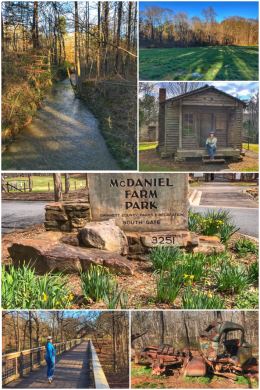
We also decided to visit several local parks, including Alexander Park, a 91-acre facility on the south end of Lawrenceville, which has a nice 1-mile gravel walking path that almost parallels a 1.4-mile paved multi-use trail. But we loved McDaniel Farm Park — so much so that we visited it twice. Located in Duluth, this 128-acre park — a former cotton farm — has been restored to depict a typical 1930s subsistence farm in Gwinnett County, including several historic buildings (such as the farmhouse, tenant farmer house, barn, and blacksmith shop). The park offers 3-miles of paved multi-purpose and soft-surface trails that wind through woodlands and along and over streams, with the paved path recognized as a National Recreation Trail — one of 1,150 trails in all 50 states that exist to contribute to health, conservation, and recreation goals. As you can see in the photo, more daffodils were up and blooming at the park.
In the midst of our long stay north of Atlanta, we decided we had to take a short trip to the Great Smoky Mountains National Park — and you can follow the link to read about our fun experience in the mountains — with the wide variety of trees, as well as many streams, rivers, and waterfalls.
Amicalola Falls State Park
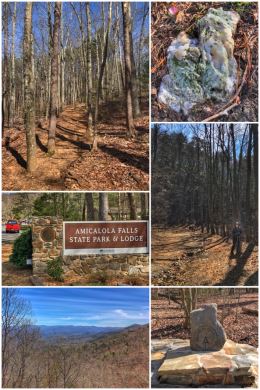
Speaking of waterfalls, if you are in the Atlanta area (or anywhere to the north), you should definitely plan a visit to Amicalola Falls State Park, located within the Chattahoochee National Forest. This 829-acre park near Dawsonville (about 70 miles north of Atlanta) is home to the tallest waterfall in Georiga (and the third-highest cascading waterfall east of the Mississippi River)… a beautifully cascading 729-foot waterfall. The falls are considered to be one of the state’s Seven Natural Wonders. The headwaters of the falls come together from high elevation springs, forming Little Amicalola Creek, which continues to flow south in the Amicalola River (eventually leading to the Gulf of Mexico).
Besides the falls, the park also offers hiking trails, a guest lodge, restaurant, cabins, a shelter for long-distance Appalachian Trail hikers, a campground, and access to the eco-friendly Len Foote Hike Inn (accessible only via hiking trails).
The name of the falls (and park) come from the Cherokee (like many other places in the state) word Um-Ma-Calo-La meaning “tumbling waters.”
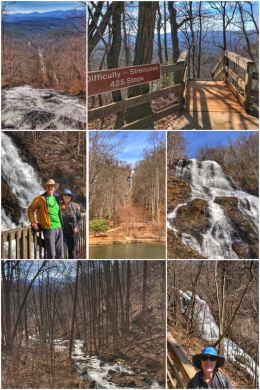
There are two main ways to see all of the falls — from the top to the base — if you are hiking. (If you are driving, you can simply drive and park at the reflection pool at the base or drive up to the top of the falls and park there.)
We chose to hike the high route, climbing up the East Ridge Trail, which starts outside the back of the visitor center. The trail climbs
725 feet through a young hardwood forest, carving through wide switchbacks before reaching a gravel road — where you turn left (northbound) toward the top of the falls. Along the way, there are multiple overlooks with spectacular views of the nearby mountains. Once at the top, you cross over the top of the falls and begin the descent down the west side of the falls — along a series of metal stairs and landings… continuing along the Appalachian Approach Trail back to the visitor center — for an amazing almost 3-mile loop.
The visitor center has LOTS of information and gifts related to the Appalachian Trail (AT), one of a handful of National Scenic Trails — and the Appalachian Approach Trail leads to Spring Mountain, the southern terminus of the 2,150-mile Appalachian Trail. Thru-hikers can register or check-in for the AT and get advice from the staff before heading out for that massive journey.
More Civil War Battlefields
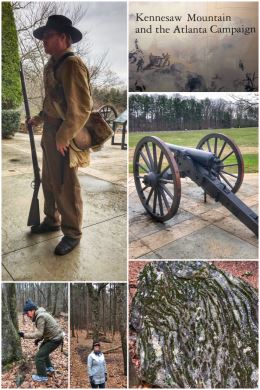
The next day we met up with Ran’s brother Brad again for an educational experience and some hiking at Kennesaw Mountain National Battlefield Park, located in Kennesaw — about 23 miles northwest of Atlanta — and administered by the National Park Service. The 2,923-acre park preserves one of the key battleground areas on the Union’s march to take Atlanta in the Civil War — during June to July 1864.
The three battlefield areas include: at the Visitor Center, off Burnt Hickory Road, and a major site at Cheatham Hill (commonly known as the Dead Angle). Most of the fighting took place in an area known as Pigeon Hill… and in the end, 5,350 soldiers died during the battles, and while the Confederates actually won, they quickly retreated closer to Atlanta, deciding that the Chattahoochee River would make a better natural barrier for stopping the Union advance.
We started with a short lecture on the life of an infantryman — with a park ranger dressed in Confederate garb, as shown in the top left photo. We discussed his uniform and the accompanying elements — including rifle, ammunition, food, shoes, and sleeping carpet. He discussed that this park receives three times the number of visitors than Gettsyburg, which was very surprising to us — and when we attempted to look up statistics, it seems as though both parks receive more than a million visitors annually.
The visitor center also has a Civil War museum and a very informative film on the Union advance on Atlanta — and the importance of taking Atlanta for President Abraham Lincoln’s 1864 re-election chances. (The Union did take Atlanta and Lincoln won re-election in a landslide. Sadly, Lincoln was then assassinated in April 1865.) Atlanta was an extremely important transportation hub for the south — with four railroad lines converging on the city.
One of the interesting facts we learned is that more than 20,000 American Indians fought in the Civil War.
Multiple trails and hikes abound in the park — with one of the most popular climbing to the summit of Kennesaw Mountain, which we had planned to do but the poor weather changed our plans — which is about a 2-mile loop from the Visitor Center. We instead hiked the Environmental Loop Trail, a short (1.33-mile) hike. This hike was fun and informative — and even included a few metamorphic rocks (as shown in the bottom right of the collage).
You can find maps online or at the Visitor Center — for the northern, central, and southern sections of the park.
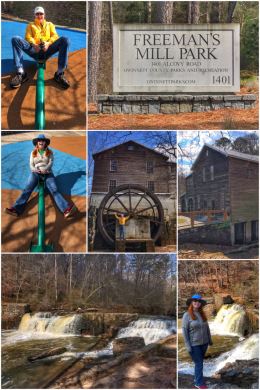
Next up on the agenda was exploring a few more local parks and green spaces.
We started with a fun exploration of Freeman’s Mill Park, located right in Lawrenceville, along the banks of the Alcovy River. The 12-acre park preserves a restored historic gristmill (the last operating mill in Gwinnett County), and also includes a short (.5-mile) multi-use trail, playground, and restrooms. An old dam provides a small, cascading waterfall.
From the 1860s to 1986, the old gristmill was used to grind wheat and corn from local farmers into flour and meal. The mill was powered by a dam that funneled water from the river into a large waterwheel. Later, the Alcova Baptist Church used the mill pond for baptisms.
As you can see in the collage, we took a break to be a bit silly and try the tetter-totter in the playground… which turned out to be a bit too small for us!

We then took a longer hike with an adventure up to Cherokee Bluffs Park in Hall County — located on Blackjack Road in Flowery Branch. The 168-acre park has rolling meadows, streams, natural shoals, native wildlife, and historic sites; facilities include multi-use trails, a simple lodge and bandshell, plus a picnic shelter and dog park.
We hiked the main trail, officially called Bear Paw Trail (though AllTrails calls it the Cherokee Park Trail), a 2.2-mile loop around the park. It’s a wonderfully looping trails with different elevations — though the highlight of the hike is the granite outcroppings that are referred to by local residents as “Stone Mountain’s Toenails.” The outcroppings sit high above other parts of the park, thus the bluffs. In addition to the bluffs, there is a 3-acre lake (Dragonfly Lagoon) on the property in a low lying wooded area in the middle of the property.

We ended the day with another wonderful experience at our Townplace Suites hotel.
We sometimes have waffles or pancakes for dinner — as we are rarely hungry enough in the morning to eat that much food. And, by the way, the waffles we eat are keto-friendly almond flour waffles, which we slather in butter and then pour on our Lakanto (maple-flavored, monk-fruit) syrup.
The problem for us, of course, is that our waffle iron was sitting in our trailer, locked away at the shop. Happily, the Townplace Suites where we were staying had the equipment in their breakfast bar area — and the staff was more than accomodating in allowing us to access to use them in the evening — so that we could have those wonderful, golden-brown and yummy waffles. Again, we can’t say enough about the customer service at this hotel — and also about the power of good customer service to make us feel heard and appreciated.
More Waterfalls
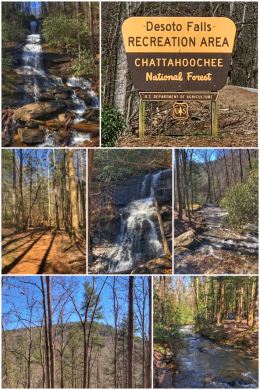
As the days finally drew near when our travel trailer was going to be fully repaired and ready to be picked up, we decided to venture up into the 749,689-acre Chattahoochee National Forest in the North Georgia mountains for two great hikes — and several more beautiful waterfalls and vistas. (The national forest is named for the Chattahoochee River, whose headwaters begin in North Georgia. Chattahoochee, of course, comes from the name the Cherokee Indians gave the river — Chatta meaning stone; ho chee, marked or flowered… flowered stone river. One more fun fact: The national forest began when the forest service purchased 31,000 acres in Fannin, Lumpkin, and Union Counties from the Gennett family in 1911 for $7 per acre.)
We started with Desoto Falls, located in Lumpkin County, along Frogtown Creek. Fun fact: The name comes from the discovery of a breastplate in the 1880s believed to be from one of the men from Hernando de Soto’s exploration of the area when he was leading the first Spanish and European expedition of what became the southeast United States back in the 1500s.
There are actually three falls in this area, but only two are now accessible by trail. Once you cross the bridge from the campground, you have a choice of going left to the lower falls (a short, .5-mile RT, hike with switchbacks) or right to the upper falls (a longer, 1.5-mile RT, hike through rolling hills up to the falls). Both hikes — and falls — are beautiful in their own way, and at about 2 miles roundtrip, a fairly easy hike to see such scenery and experience the two falls.
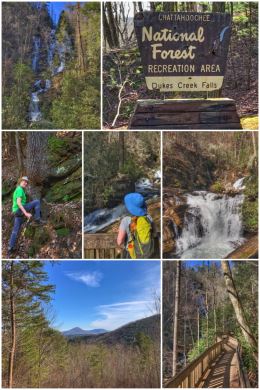
We ended the day with another hike at a fairly nearby waterfall — Dukes Creek Falls — located about 20 miles east of DeSoto Falls. Both of these waterfalls are about 90 miles north of Atlanta.
The hike to the falls from the parking lot was about 2.9-mile RT, with the first part of the trail an ADA accessible paved trail that leads to an overlook with a peek at the falls far below. From the overlook, the trail continues down a series of stairs onto an old forest road for a nice hike in the woods (and along the creek), before taking a sharp switchback down to the falls. When you get to the base, you discover several cascading waterfalls tumbling at the convergence of Davis Creek and Dukes Creek. At the falls, several viewing platforms offer multiple views of the main attraction: the dramatic, multi-tiered, 150-foot-tall drop of Dukes Creek Falls.
There are also a number of wineries located in the area, but we chose not to visit any of them. We’re not sure what is up with Georgia wine-tasting, but we are not willing to pay $20-30 for wine-tasting — anywhere. We have appreciated the many wineries where the tastings are free and we are okay with a $5-8 tasting fee, but when it hits double digits, the wine has to be exceptional… and Georgia wines are not so.
Finally Back on the Road!
We finally were able to pick up the trailer — more than three weeks after the accident — only to discover in the hotel parking lot that the repair shop had not been plugging in the unit, as they promised us they were doing — and we sat there with a slide that would not operate. We decided to charge the battery with our Goal Zero Yeti electric generator all night… and not so amazingly, the battery was fully charged the next morning and the slide shut normally.
We hit the road for the Chatanooga, Tennessee, area… more than ready to continue this journey in peace.
Georgia will forever be remembered for the highs of reconnecting and rejoicing in family and the lows of a tire blowout and being stuck in a hotel for three weeks waiting for the repairs — and the many problems associated with those repairs.
The Original Itinerary
By the way, for those folks interested in our route planning. After leaving Atlanta, our plans were to head up to Greenville, South Carolina, for a few days before moving on to Ashville, North Carolina. From Ashville, moving on to the Great Smoky Mountains and then down into Chatanooga and the rest of Tennessee. As previously mentioned, we did get to spend some time in the Great Smoky Mountains — not just as much as we had planned — and we have had to truncate our time exploring Tennessee as well… which will be discussed in our next blog post.
